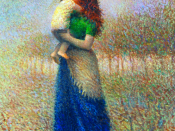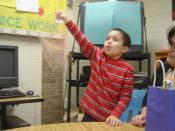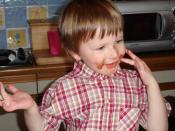Good report for Autism. "Informative, good organization"
Hajducko 1
Steven Hajducko
Prof. Sims
MWF 10:00-11:00
29 November 1995
False Words and False Hope
Autism is a childhood disease where the child is in a private world of their
own. A description of an autistic child by her mother is:
We start with an image---a tiny, golden child on hands and knees,
circling round and round a spot on the floor in mysterious self-
absorbed delight. She does not look up, though she is smiling
and laughing; she does not call our attention to the mysterious
object of her pleasure. She does not see us at all. She and the
spot are all there is, and though she is eighteen months old, an
age for touching, tasting, pointing, pushing, exploring, she is doing
none of these. (Groden 2)
This is the most important trait in an autistic child: They don't interact or
socialize with other people.
Other characteristics in autistic children are
language retardation and ritualistic or compulsive behaviors. It used to be
thought that children became autistic because of 'poor parenting' and that the
only solution was that the parents should be removed from the child (Baron-
Cohen 26). Now it is known that autism is caused by biological factors due to:
neurological symptoms, mental handicap, genetic causes, infections, and even
difficulties in pregnancy.
Even though autism is thought of as a disease or disorder, autistic
Hajducko 2
children can demonstrate special skills. These skills are referred to as 'isolated
islets of intelligence' (Baron-Cohen 53). Some examples of these are found in
an autistic child's ability to draw, play music, or recall a certain date. Nadia, an
autistic child, has the ability to draw in an 'almost photographic way' (Baron-
Cohen 54). Autistic children can also play instruments, accurately sing...



Well written and informative
It's a very interesting and smooth read an it seems well researched, too. I really enjoyed getting new information on this topic. Especially in this manner. But it an important piece: the citings...
1 out of 1 people found this comment useful.